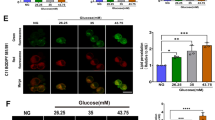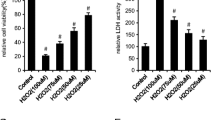Abstract
High glucose (HG) state is closely related to diabetic complications, and among these one main pathogenesis involves apoptosis of important functional cells. However, the mechanism of osteoblast (OB) apoptosis induced by HG state is not clear. Peroxynitrite (ONOO), the strongest oxidant, can mediate apoptosis in various kinds of cells, including OB. Therefore, this study was aimed at investigating whether HG state could induce OB apoptosis through ONOO-. Cultured OB from rat calvariae explanted from E21 fetuses were treated with HG solution. The ratio of OB apoptosis and ONOO-content was assayed by TUNEL, flow cytometry, and immunohistochemistry. The results showed that HG state could induce ONOO-overformation (p<0.01), and excessive OB apoptosis (p<0.001). However, the HG-induced OB apoptosis could be attenuated by peonol, a potent scavenger of ONOO-. In conclusion, HG state might trigger excessive ONOO-formation, mediating OB apoptosis.
Similar content being viewed by others
References
Hsieh CH, Hung YJ, He CT, et al. The capability of glucose toxicity on severe type 2 diabetes. Endocr Res 2005, 31: 149–58.
Santilli F, Cipollone F, Mezzetti A, Chiarelli F. The role of nitric oxide in the development of diabetic angiopathy. Horm Metab Res 2004, 36: 319–35.
Vincent AM, McLean LL, Backus C, Feldman EL. Short-term hyperglycemia produces oxidative damage and apoptosis in neurons. FASEB J 2005, 19: 638–40.
Takamoto I, Kadowaki T. Diabetes and osteoporosis. Clin Calcium 2004, 14: 255–61.
Qi JS, Ling YL, Zhang XL, Wu M, Xue ZQ, Xiao H. Immunohistochemistry study on the role of peroxynitrite in diabetic rat osteoporosis. Chinese Journal of Pathophysiology 2005, 21: 2035–8.
Davì G, Falco A, Patrono C. Lipid peroxidation in diabetes mellitus. Antioxid Redox Signal 2005, 7: 256–68.
Mastrocola R, Restivo F, Vercellinatto I, et al. Oxidative and nitrosative stress in brain mitochondria of diabetic rats. J Endocrinol 2005, 187:37–44.
Freeman B. Free radical chemistry of nitric oxide. Looking at the dark side. Chest 1994, 105 (3 Suppl): 79S–84S.
Aydogan S, Yerer MB, Goktas A. Melatonin and nitric oxide. J Endocrinol Invest 2006, 29: 281–7.
Virag L, Szabo E, Gergely P, Szabo C. Peroxynitrite-induced cytotoxicity: mechanism and opportunities for intervention. Toxicol Lett 2003, 140-1: 113–24.
Chou TC. Anti-inflammatory and analgesic effects of paeonol in carrageenan-evoked thermal hyperalgesia. Br J Pharmacol 2003, 139: 1146–52.
Hsieh CL, Cheng CY, Tsai TH, et al. Paeonol reduced cerebral infarction involving the Superoxide anion and microglia activation in ischemia-reperfusion injured rats. J Ethnopharmacol 2006, 106: 208–15.
Zou MH, Shi C, Cohen RA. High glucose via peroxynitrite causes tyrosine nitration and inactivation of prostacyclin synthase that is associated with thromboxane/prostaglandin H(2) receptor-mediated apoptosis and adhesion molecule expression in cultured human aortic endothelial cells. Diabetes 2002, 51: 198–203.
Martin LJ, Chen K, Liu Z. Adult motor neuron apoptosis is mediated by nitric oxide and Fas death receptor linked by DNA damage and p53 activation. J Neurosci 2005, 25: 6449–59.
Kelpke SS, Reiff D, Prince CW, Thompson JA. Acidic fibroblast growth factor signaling inhibits peroxynitrite-induced death of osteoblasts and osteoblast precursors. J Bone Miner Res 2001, 16: 1917–25.
Taguchi K, Kobayashi T, Hayashi Y, Matsumoto T, Kamata K. Enalapril improves impairment of SERCA-derived relaxation and enhancement of tyrosine nitration in diabetic rat aorta. Eur J Pharmacol 2007, 556: 121–8.
Bell MA, Scarrow WG. Staining for microvascular alkaline phosphatase in thick celloidin sections of nervous tissue: morphometric and pathological applications. Microvasc Res 1984, 27: 189–203.
Casey RG, Gang C, Joyce M, Bouchier-Hayes DJ. Taurine attenuates acute hyperglycaemia-induced endothelial cell apoptosis, leucocyte-endothelial cell interactions and cardiac dysfunction. J Vasc Res 2007, 44: 31–9.
Takizawa M, Kameyama K, Maruyama M, Ishida H. Bone loss in type 2 diabetes mellitus—diabetic osteopenia. Nippon Rinsho 2003, 61: 287–91.
Weinstein RS, Manolagas SC. Apoptosis and osteoporosis. Am J Med 2000, 108: 153–64.
Xing L, Boyce BF. Regulation of apoptosis in osteoclasts and osteoblastic cells. Biochem Biophys Res Commun 2005, 328: 709–20.
Terada M, Inaba M, Yano Y, et al. Growth-inhibitory effect of a high glucose concentration on osteoblast-like cells. Bone 1998, 22: 17–23.
Pennathur S, Heinecke JW. Mechanisms of oxidative stress in diabetes: implications for the pathogenesis of vascular disease and antioxidant therapy. Front Biosci 2004, 9: 565–74.
Gross A, Dugas N, Spiesser S, et al. Nitric oxide production in human macrophagic cells phagocytizing opsonized zymosan: direct characterization by measurement of the luminol dependent chemiluminescence. Free Radic Res 1998, 28: 179–91.
Ortega Mateo A, Amaya AA. Nitric oxide reactivity and mechanisms involved in its biological effects. Pharmacol Res 2000, 42:421–7.
Beckman JS, Koppenol WH. Nitric oxide, Superoxide, and peroxynitrite: the good, the bad, and the ugly. Am J Physiol 1996, 271: C1424–37.
Peluffo H, Shacka JJ, Ricart K, et al. Induction of motor neuron apoptosis by free 3-nitro-L-tyrosine. J Neurochem 2004, 89: 602–12.
Amici M, Lupidi G, Angeletti M, Fioretti E, Eleuteri AM. Peroxynitrite-induced oxidation and its effects on isolated proteasomal systems. Free Radic Biol Med 2003, 34: 987–96.
Vinten-Johansen J. Physiological effects of peroxynitrite: potential products of the environment. Circ Res 2000, 87: 170–2.
Ceriello A, Quagliaro L, D’Amico M, et al. Acute hyperglycemia induces nitrotyrosine formation and apoptosis in perfused heart from rat. Diabetes 2002, 51: 1076–82.
Author information
Authors and Affiliations
Corresponding author
Rights and permissions
About this article
Cite this article
Qi, J.S., Li, Y.N., Zhang, B.S. et al. Peroxynitrite mediates high glucose-induced osteoblast apoptosis. J Endocrinol Invest 31, 314–320 (2008). https://doi.org/10.1007/BF03346364
Accepted:
Published:
Issue Date:
DOI: https://doi.org/10.1007/BF03346364




